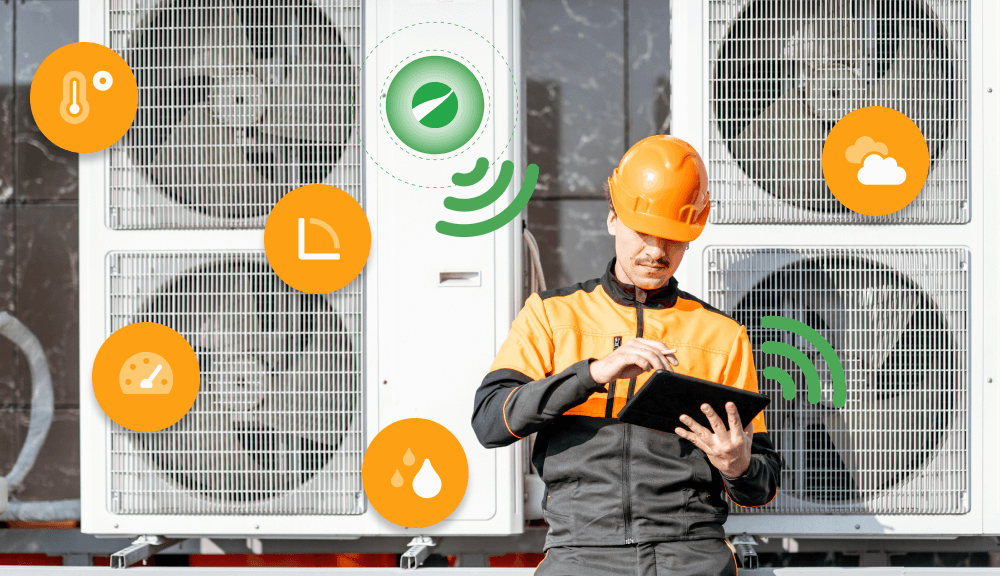IoT Sensors for Facility Management in Commercial Buildings

IoT sensors, like all IoT-connected devices (which reached the number of over 13 billion worldwide), can significantly improve the management of commercial buildings by providing real-time data on various facility areas. They can be used to monitor temperature, humidity, air quality, and other factors that impact the comfort and efficiency of a building.
By gathering and analyzing this data, facility managers can make informed decisions about optimizing the building's performance.
IoT sensors in commercial buildings can also improve occupant comfort, reduce maintenance costs, and increase efficiency. And as technology continues to evolve, the potential for even greater benefits will only continue to grow.
So, implementing IoT sensors for facility management in commercial buildings can be a wise decision for facility managers. Let's explore the exciting world of IoT sensors and how it's transforming facility management in commercial buildings.
IoT Sensors for Facility Management in Commercial Buildings
Many types of IoT sensors can be used for facility management in commercial buildings. Some of the most popular types include:
- Temperature sensors
- Humidity sensors
- Air Quality sensors
- Energy Usage sensors
- Motion sensors
- Lighting sensors
- Water sensors
1. Temperature Sensors
Temperature sensors can be an essential tool for facility management in commercial buildings. They have the following uses:
-
Monitor Temperature
They can monitor the temperature in different areas of a building, ensuring that the environment is comfortable for tenants.
-
Detect Temperature Anomalies
They can detect temperature variations that may indicate a malfunctioning heating or cooling system, allowing facility managers to address these issues before they become a problem.
-
Optimize Heating and Cooling Systems
They can be integrated with a computer-aided facility management (CAFM) system, also known as an IoT building management system, to provide real-time data on the temperature in different building areas. This data can be used to optimize the building's heating and cooling systems.
Integrating temperature sensors with a CAFM system can help facility managers optimize the performance of a building's heating and cooling systems and improve occupant comfort.
2. Humidity Sensors
Humidity sensors are also quite useful IoT smart building solutions. They have the following uses:
-
Monitor Humidity Levels
They can be used to monitor the humidity levels in different areas of a building, helping facility managers identify areas that may be at risk of mold growth or other issues.
High humidity levels can lead to many problems, such as damage to building materials, discomfort for tenants, and increased energy costs due to the need for more frequent heating and cooling.
-
Detect Humidity Across Building Areas
IoT sensors can be integrated with CAFM systems to provide real-time data on the humidity levels in different areas of the building. This data can be used to identify areas where the humidity levels are too high and take action to address the issue.
Humidity sensors, along with CAFM systems, can help facility managers improve the comfort and health of a building's occupants and reduce energy costs and protect the building's materials.
3. Air Quality Sensors
Indoor air quality (IAQ) refers to the air quality inside a building. It can significantly impact the health, comfort, and productivity of the building's tenants.
Many factors can affect IAQ, including ventilation, the presence of pollutants such as dust and mold, and the humidity level. Let's look at how air quality sensors improve the air quality inside a building:
-
Real-time Monitoring
These sensors detect changes in air quality and transfer that data to a CAFM system that provides real-time data on the air quality in different building areas, allowing facility managers to identify issues as they arise.
-
Improved Comfort
Poor air quality can cause discomfort for building inhabitants, reducing productivity and satisfaction. IAQ sensors can assist in enhancing the comfort of building occupants by monitoring air quality — for example, CO2 levels or TVOC — allowing facility managers to take action to improve it.
-
Enhanced Productivity
Inadequate air quality might decrease productivity among building inhabitants. An IAQ sensor can assist in increasing the productivity of building tenants by checking appropriate air quality.
Information about deviations from the norm can indicate that, for example, there is a need to ventilate the rooms more frequently or uphaul the ventilation system.
-
Energy Conservation
Poor air quality is frequently caused by inadequate heating and cooling systems. An IAQ sensor supported by a CAFM system can help preserve energy and cut energy expenses by monitoring air quality and managing building systems.
4. Energy Usage Sensors
Energy-use IoT sensors are devices that measure the energy consumption of various systems in a building. These sensors may offer real-time data on energy use, enabling facility managers to detect possibilities for energy reduction and any problems causing excessive energy consumption. Moreover, they provide specific information relevant to ESG reporting.
Let's take a look at how energy-use IoT sensors improve facility management functions:
-
Provide Real-time Statistics
An energy-use IoT sensor integrated with a CAFM system may offer real-time statistics on the energy use of various building systems, including lighting, heating and cooling, and appliances.
-
Lower Energy Costs
These sensors can assist facility managers in lowering energy expenses and improving building efficiency by monitoring energy consumption and finding conservation possibilities.
-
Detect Energy Use Anomalies
Energy-use sensors may identify unexpected patterns in energy use, which may signal a faulty system. They can help facility managers save on costly repairs and downtime.
-
Increase Compliance
Energy efficiency laws and reporting requirements apply to many structures. Energy-use sensors may assist site managers in ensuring compliance with these laws by giving real-time statistics on energy use.
5. Motion Sensors
Motion sensors can identify individuals in various regions of the building and offer real-time IoT data on their movements. This data may be used to improve the building's performance and the comfort and convenience of its occupants.
Let's look at ways motion sensors improve facility management:
-
Tenant Tracking
Motion sensors can assist facility managers in tracking people's movements within a structure. This data may be utilized to adjust the building's layout and increase the flow of foot traffic.
-
Security
Motion sensors in a building can detect unusual behavior and inform facility management or security officers. This can assist in strengthening building security and guard against potential attacks.
-
Maintenance
Motion sensors can assist facility managers in identifying high-traffic areas of the building, allowing them to prioritize maintenance chores in these areas.
6. Lighting Sensors
These IoT sensors can identify humans in various regions of the building and offer real-time IoT data on the quantity of light in a space. This data may be used to adjust a building's lighting and increase the comfort and convenience of its residents.
Lighting sensors may also be used to increase security and optimize building lighting. They can notify facility managers or security staff of possible dangers, helping them ensure the safety of the building and its inhabitants.
7. Water Sensors
Water sensors detect water in various building locations and offer real-time data about water use and flow. This data can be used to optimize water usage in a building and increase the efficiency of the building's systems.
Let's look at ways water sensors help facility managers:
-
Water Conservation
Water sensors can assist facility managers and tenants in reducing water consumption and improving the efficiency of the building's systems by monitoring water use in various sections of the building and identifying possibilities for conservation.
-
Identifying Malfunctions
Leakage sensors may identify anomalous patterns in water use or flow, which may indicate a faulty system. When integrated with a CAFM system, they can help facility managers reduce costs and downtime by alerting them to these concerns beforehand.
The Bottom Line
IoT sensors can significantly improve commercial buildings' efficiency, comfort, and security. But when they're integrated with CAFM systems, IoT sensors can perform real-time monitoring and data analysis.
It helps facility managers optimize the performance of a building's systems, identify opportunities for improvement, make informed decisions, and take timely action to address any issues.
So, if you're looking for a CAFM system already integrated with IoT sensors, you can check out Singu FM — a facility management system that comes with temperature, humidity, and various other sensors. It is a powerful tool for facility management in commercial buildings.
Singu FM provides a host of data visualization and analysis tools. Their platform comes with features like IoT sensors integration, allowing you to track and analyze data from your connected devices easily.

Plus, Singu FM strongly believes in collecting environmental, social, and governance (ESG) data, enabling you to track your performance in areas like, for example, temperature and air quality with the use of IoT. Such data help care about the work comfort of tenants who may observe such parameters in Singu Tenant App.
Their platform also allows for easy comparison of data from multiple locations, helping you identify patterns, outliers, and trends, allowing you to make more informed decisions.
Author: Velis
Follow Us
TRENDING POST
Tags
- Proptech (45)
- Real Estate Services (22)
- IoT (17)
- Singu Tenant App (16)
- Facility Management (14)
- Events (7)
- AI (6)
- ESG (6)
- Smart Security (5)
- BIM (4)
- Guest Management (3)
- 2019-03-06 (2)
- 2019-04-02 (2)
- workplace (2)
- Digital Twin (2)
- VR (2)
- Blockchain (2)
- retail (2)
- 2019-04-06 (1)
- 2019-04-03 (1)
- 2019-03-12 (1)
- 2019-05-14 (1)
- 2019-04-04 (1)
- 2019-03-15 (1)
- 2019-06-04 (1)
- 2019-06-25 (1)
- coworking (1)
- CMMS (1)
- Construction (1)
- 2019-04-03-04 (0)






